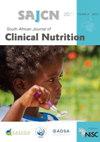南非成年患者的测量身高和根据已发表的方程预测的身高之间的一致性
IF 0.6
Q4 NUTRITION & DIETETICS
引用次数: 1
摘要
目的:基于不同身体段的估计方程通常用于预测无法直接测量身高的患者的身高。这项研究旨在评估在南非公立医院环境中,测量(参考)身高和根据身体节段测量得出的已发表方程预测的身高之间的一致性。设计:进行了一项描述性的横断面研究。设置:布隆方丹三家公立医院的医疗、外科、肺部、骨科、心血管和普通病房。受试者:入院患者,20-50岁;能够在没有帮助的情况下直立,并且没有影响身高的医疗条件或治疗。结果测量:采用标准化技术测量Stadiometer身高、卧位高度、臂展、半展、尺骨长度、膝盖高度、胫骨长度、腓骨长度和脚长。通过95%置信区间(CI)和Bland–Altman分析,将12个已发表方程预测的身高与视距仪身高进行了比较。结果:样品的中位视距仪高度(n = 141;女性38.3%;中位年龄38.8岁,IQR 33.3–44.4岁)为165.5 厘米(雄性169.3 厘米女性158.4 cm)。只有一组基于膝盖高度并以美国<65岁的大量成年人为标准的方程估计了身高,而与视距仪的身高没有统计学上的显著偏差。结论:在南非公共卫生环境中,大多数适用于住院成年人的标准化方程得出的身高估计值与身高有显著差异。因此,在其他人群中标准化的方程式可能不适合南非人群,这可能是由于遗传和环境因素的差异。本文章由计算机程序翻译,如有差异,请以英文原文为准。
Agreement between measured height, and height predicted from published equations, in adult South African patients
Objectives: Estimation equations based on different body segments are commonly used to predict height in patients whose height cannot be directly measured. This study aimed to assess the agreement between measured (reference) height and height predicted from published equations derived from measurement of body segments, in a South African public hospital setting. Design: A descriptive cross-sectional study was undertaken. Setting: Medical, surgical, pulmonary, orthopaedic, cardiovascular and general wards at three public hospitals in Bloemfontein. Subjects: Admitted patients, 20–50 years old; able to stand upright without assistance and without medical conditions or treatments affecting height. Outcome measures: Stadiometer height, recumbent height, arm span, demi-span, ulna length, knee height, tibia length, fibula length and foot length were measured with standardised techniques. Height, predicted by 12 published equations, was compared with stadiometer height by 95% confidence intervals (CI) and Bland–Altman analysis. Results: The median stadiometer height of the sample (n = 141; 38.3% female; median age 38.8 years, IQR 33.3–44.4 years) was 165.5 cm (males 169.3 cm; females 158.4 cm). Only a set of equations based on knee height and standardised on a large population of adults < 65 years in the United States estimated height without statistically significant deviance from the stadiometer height. Conclusions: Most standardised equations applied to hospitalised adults in a South African public health setting resulted in height estimations that differed significantly from height. Thus, equations standardised on other populations may not be suitable for the South African population, possibly due to differences in genetic and environmental factors.
求助全文
通过发布文献求助,成功后即可免费获取论文全文。
去求助
来源期刊

South African Journal of Clinical Nutrition
NUTRITION & DIETETICS-
CiteScore
2.50
自引率
9.10%
发文量
21
期刊介绍:
1.The Journal accepts articles from all basic and applied areas of dietetics and human nutrition, including clinical nutrition, community nutrition, food science, food policy, food service management, nutrition policy and public health nutrition. 2.The Journal has a broad interpretation of the field of nutrition and recognizes that there are many factors that determine nutritional status and that need to be the subject of scientific investigation and reported in the Journal. 3.The Journal seeks to serve a broad readership and to provide information that will be useful to the scientific community, the academic community, government and non-government stakeholders in the nutrition field, policy makers and industry.
 求助内容:
求助内容: 应助结果提醒方式:
应助结果提醒方式:


